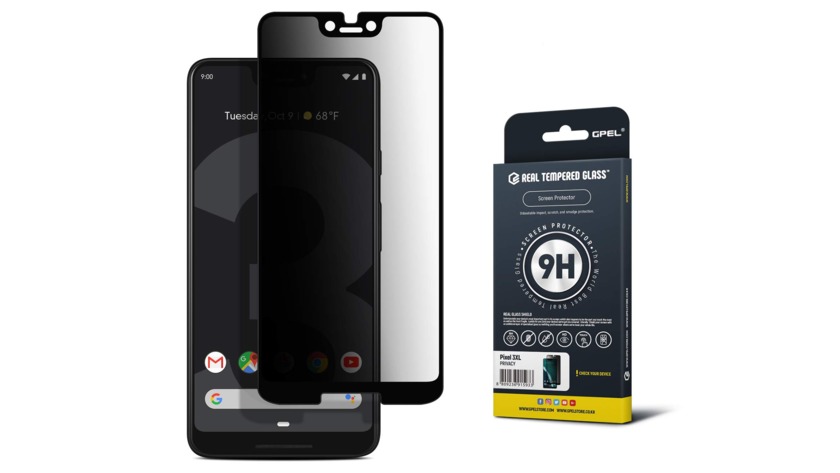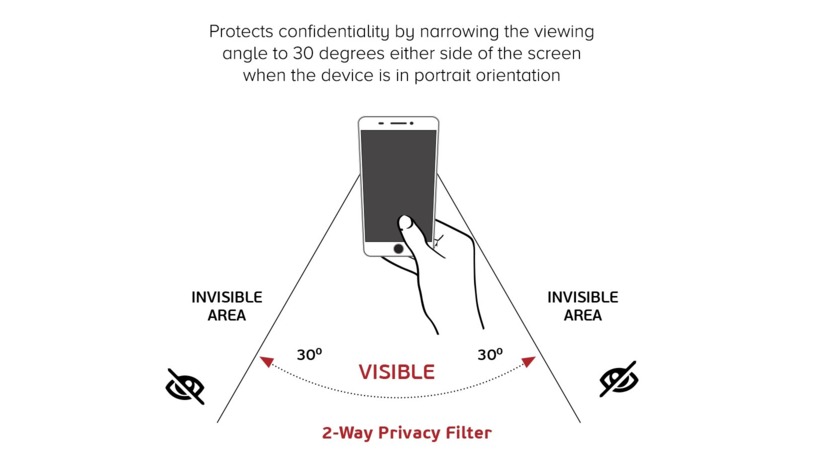![]()
Better encryption, 2-factor authentication, and other security features help us keep our data safe online. However, it might be something as simple as a stranger cozying up to you without your knowledge that could ultimately cause the biggest privacy issues. If this is something you’re worried about, using a privacy screen protector can make all the difference. What are they and how do they work? Here’s everything you need to know about privacy screen protectors!
What is a privacy screen protector?
A privacy screen protector serves double duty as a screen protector to keep your smartphone display in pristine condition while also helping to keep away prying eyes in the dark. Like a regular screen guard, these can be of the PET film or tempered glass variety, but come with an additional anti-spy filter or layer that limits the viewing angle of your display. This ensures that no one else can see what’s on your screen but you.
Do you need a privacy screen protector?
“Visual hacking” is a fancy way of describing someone who sits or stands next to you in a public place and looks at what you’re doing on your phone. It may seem harmless, but it’s definitely something we need to be wary about, given that many of us do basically everything on our smartphones.
Using phones has become so second nature that we don’t think about the surprising amount of sensitive information that’s accessible through our smartphones, be it email accounts, bank and card info, personal pictures, and more.
A lot of key information can be gleaned off of your smartphone screen while you unknowingly scroll or type away on it.
It’s not even just about malicious intent either. It could even be as simple as you not wanting the person next to you on public transportation to know what you’re watching, what websites you’re visiting, and more. We do a lot on our smartphones, but nobody else but you should know what that is.
How do privacy screen protectors work?
Most privacy screen protectors use a form of micro louver technology that allows light from the phone to display to pass through only at certain angles. This can basically be compared to how Venetian window blinds work, but at a microscopic scale. The filter layer is set to a narrow front angle, usually 60 or 90 degrees, and anyone looking at your screen from beyond that viewing angle will only see a darkened screen.
Best privacy screen protectors and what to look for
There are quite a few different choices available when you start the search for a privacy screen factor. There are some key factors worth considering before you make a purchase though.
- Micro louver technology – Check that the privacy screen protector you want to buy incorporates some type of micro louver technology. Some cheap privacy screen protectors are essentially just darkened glass or film that kills the viewing angle but affects the brightness and display clarity as well. Screen protectors that utilize micro louver technology aren’t perfect, but the viewing experience is definitely better.
- Tempered glass or film – This actually comes down to personal preference and what kind of display protection you are looking for. Both types of screen protectors are available with privacy filters or layers. However, finding full coverage with a tempered glass panel can be a touch difficult since a lot of current generation phones feature curved screens and edges. If you do get complete coverage, it might also not play well with cases.
- 2-way or 4-way privacy – This determines the orientation in which the privacy screen protector is effective. A 2-way filter shows a darkened screen in only the portrait orientation. The obvious advantage here is that if you want to share something on your phone, all you have to do is turn the phone to landscape. However, if complete privacy is what you are looking for, 4-way privacy filters ensure functionality in both orientations.
- Viewing angle – The viewing angle is an important factor for a couple of reasons. It has to be narrow enough so that people standing or sitting next to you fall outside of this range. If a viewing angle is too wide, it kinds of defeats the purpose of having a privacy screen protector. On the flip side, if it’s too narrow, it may impact your own viewing experience. You’ll have to hold the phone completely steady and face the screen head on to make sure that you are able to see what’s on the screen properly. With most privacy screen protectors, the available viewing angle is usually 60 or 90 degrees.
Advantages
The most obvious advantage of using a privacy screen protector is in the name: privacy. There’s certainly a greater peace of mind available in the knowledge that you can look at sensitive information on your smartphone while avoiding the prying gaze of bystanders.
It isn’t just about privacy in public areas either. If a spouse, partner, or roommate gets annoyed at the fact that you are on your phone all night, a privacy screen protector is a great way to alleviate this issue. It guarantees that they aren’t disturbed by the light from your phone, while you can continue to enjoy it without any issues.
Related: Best Android security practices
Of course, the privacy screen protector also gives you the same advantage as a regular screen protector. It provides a great way to keep the display free of scratches and safe during accidental bumps and drops.
Other advantages are often manufacturer-specific. Some screen protectors come with an anti-glare coating, blue light filter, filters to reduce eye strain, and oleophobic and hydrophobic coatings to keep the protector free from fingerprint and oil smudges.
Disadvantages
As wonderful as privacy screen protectors sound on paper, the reality is a little bit different. Many privacy screen protector makers promise no issues with clarity or reduction in brightness, but that isn’t always the case.
You can overcome the issue my pumping up the brightness of the display, but this will likely result in rapid battery drain. Having the brightness too high could also reduce the effectiveness of the privacy filter when the phone is angled away.
The need to hold the phone directly in front of you also takes away those quick sideways glances at the time or notifications. This is something I, and I’m sure many of you, do quite often, and can prove to be quite annoying if you have a privacy screen protector fitted on your phone.
Sharing something that’s on your screen becomes difficult as well. You’ll have to angle it in just the right away show other people a video or a photo. 2-way privacy screens help with this problem by letting you easily show off the display in the landscape orientation. However, this won’t be possible if you get a 4-way privacy screen protector.
Finally, the viewing angle reduction may actually not be as limiting as you’d need. As low as viewing angles of 60 or 90 degrees sound, anyone standing in close proximity, say on the subway or on a bus, will still be able to see over your shoulder and get a somewhat clear view of what is happening on your screen.
Final thoughts
Privacy screen protectors are far from perfect. They aren’t going to be the ultimate privacy solution that some phone owners may want. It all comes down to your smartphone usage in public. If you are someone who likes to work on a flight, read sensitive documents during your commute, or just don’t want anyone to know what YouTube video you’re giggling at, a privacy screen protector is a great way to go.
However, if possible at all, it would be best to simply avoid accessing sensitive information while in public. Smartphone and display makers have spent millions on research to provide impressive viewing experiences with good brightness and high viewing angles. Of course, privacy trumps showing off a vivid display, and you’re the best person to judge whether a privacy screen protector is something you’ll need.
What do you think of privacy screen protectors? Let us know in the comments.
from Android Authority https://ift.tt/2UjvOF1
via IFTTT






0 comments:
Post a Comment